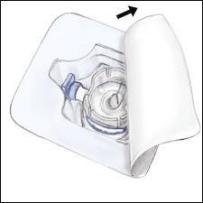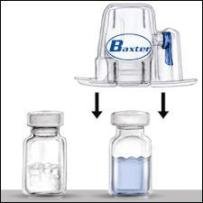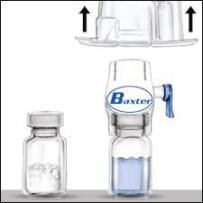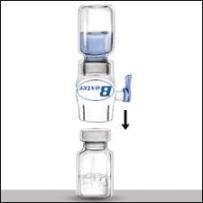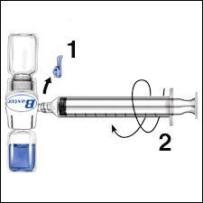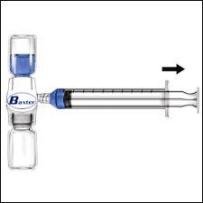ADVATE
-
antihemophilic factor, human recombinant
Baxter Healthcare Corporation
----------
|
|||||||||||||||||||||
FULL PRESCRIBING INFORMATION
1 INDICATIONS AND USAGE
1.1 Control and Prevention of Bleeding Episodes
ADVATE is an antihemophilic factor (recombinant) indicated for control and prevention of bleeding episodes in adults and children with Hemophilia A.
1.2 Perioperative Management
ADVATE is indicated in the perioperative management in adults and children with Hemophilia A.
ADVATE is not indicated for the treatment of von Willebrand's disease.
2 DOSAGE AND ADMINISTRATION
For Intravenous Use After Reconstitution only
- Treatment with ADVATE should be initiated under the supervision of a physician experienced in the treatment of hemophilia A.
- Each vial of ADVATE has the recombinant Factor VIII potency in international units stated on the label. The expected in vivo peak increase in Factor VIII level expressed as IU/dL of plasma or percent normal can be estimated by multiplying the dose administered per kg body weight (IU/kg) by 2.
- The dosage and duration depend on the severity of Factor VIII deficiency, the location and extent of the bleeding, and the patient's clinical condition. Careful control of replacement therapy is especially important in cases of major surgery or life-threatening bleeding episodes. [Control and Prevention of Bleeding Episodes (2.1) and Perioperative Management (2.2)]
The expected in vivo peak increase in Factor VIII level expressed as IU/dL (or % of normal) can be estimated using the following formulas:
IU/dL (or % of normal)=[Total Dose (IU)/body weight (kg)] × 2 [IU/dL]/[IU/kg]
OR
Dose (IU) = body weight (kg) × Desired Factor VIII Rise (IU/dL or % of normal) × 0.5 (IU/kg per IU/dL)
Examples (assuming patient's baseline Factor VIII level is < 1% of normal):
- A dose of 1750 IU ADVATE administered to a 70 kg patient should be expected to result in a peak post-infusion Factor VIII increase of 1750 IU × {[2 IU/dL]/[IU/kg]}/[70 kg] = 50 IU/dL (50% of normal).
- A peak level of 70% is required in a 40 kg child. In this situation, the appropriate dose would be 40 kg × 70 IU/dL/{[2 IU/dL]/[IU/kg]} = 1400 IU.
The dose and frequency of administration should be based on the individual clinical response. Patients may vary in their pharmacokinetic (e.g. half-life, in vivo recovery) and clinical responses to ADVATE. Although you can estimate the dose by the calculations above, it is highly recommended that, whenever possible, appropriate laboratory tests including serial Factor VIII activity assays be performed [see WARNINGS and PRECAUTIONS: Monitoring Laboratory Tests (5.4) and Pharmacokinetics (12.3)].
2.1 Control and Prevention of Bleeding Episodes
A guide for dosing in the treatment of bleeding episodes is provided in Table 1. The careful control of treatment dose is especially important in cases of life-threatening episodes.
|
||
| Degree of Hemorrhage Or Type of Bleeding Episodes | Required Peak Post-infusion Factor VIII Activity in the Blood (as % of Normal or IU/dL) | Dosage and Frequency Necessary to Maintain the Therapeutic Plasma Level |
| Minor Early hemarthrosis, mild muscle bleeding, or mild oral bleeding episode. | 20-40 | 10-20 IU/kg* Repeat infusions every 12 to 24 hours (8 to 24 hours for patients under the age of 6) for one to three days until the bleeding episode is resolved (as indicated by relief of pain) or healing is achieved. |
| Moderate Moderate bleeding into muscles, bleeding into the oral cavity, definite hemarthroses, and known trauma. | 30-60 | 15-30 IU per kg* Repeat infusions every 12 to 24 hours (8 to 24 hours for patients under the age of 6) for three days or more until the bleeding episode is resolved (as indicated by relief of pain) or healing is achieved. |
| Major Significant gastrointestinal bleeding, intracranial, intra-abdominal or intrathoracic bleeding, central nervous system bleeding, bleeding in the retropharyngeal or retroperitoneal spaces or iliopsoas sheath, Fractures, Head trauma. | 60-100 | Initial dose 30-50 IU per kg: Repeat dose 30-50 IU per kg every 8 to 24 hours (6 to 12 hours for patients under the age of 6) until resolution of the bleeding episode has occurred. |
2.2 Peri-operative Management
A guide for dosing in perioperative management is provided in Table 2. The careful control of dose and duration of treatment is especially important in cases of major surgery or life-threatening bleeding episodes.
| Type of Surgery | Required Peak Post-infusion Factor VIII Activity in the Blood (% of Normal or IU/dL) | Frequency of Infusion |
|
||
|
Minor Including tooth extraction | 60-100 | A single bolus infusion (30-50 IU/kg*) beginning within one hour of the operation. Optional additional dosing every 12 to 24 hours as needed to control bleeding. For dental procedures, adjunctive therapy may be considered. |
|
Major Examples include intracranial, Intra-abdominal, or Intrathoracic surgery, joint replacement surgery | 80-120 (pre- and post-operative) | Preoperative bolus infusion: 40-60 IU/kg*. Verify 100% activity has been achieved prior to surgery. Maintenance bolus infusion (40-60 IU/kg*) repeat infusions every 8 to 24 hours (6 to 24 hours for patients under the age of 6), depending on the desired level of Factor VIII and state of wound healing. |
2.3 Instruction for Use
ADVATE is administered by intravenous (IV) injection after reconstitution. Patients should follow the specific reconstitution and administration procedures provided by their physicians.
For instructions, patients should follow the recommendations in the FDA-approved patient labeling.
Reconstitution, product administration, and handling of the administration set and needles must be done with caution. Percutaneous puncture with a needle contaminated with blood can transmit infectious viruses including HIV (AIDS) and hepatitis. Obtain immediate medical attention if injury occurs. Place needles in a sharps container after single use. Discard all equipment, including any reconstituted ADVATE in an appropriate container.
2.4 Preparation and Reconstitution:
The procedures below are provided as general guidelines for the reconstitution and administration of ADVATE. Always work on a clean surface and wash your hands before performing the following procedures.
- Bring the ADVATE (dry factor concentrate) and Sterile Water for Injection, USP (diluent) to room temperature.
- Remove caps from the factor concentrate and diluent vials.
- Cleanse stoppers with germicidal solution, and allow to dry prior to use. Place the vials on a flat surface.
- Open the BAXJECT II device package by peeling away the lid, without touching the inside (Figure A). Do not remove the device from the package.
- Turn the package over. Press straight down to fully insert the clear plastic spike through the diluent vial stopper (Figure B).
- Grip the BAXJECT II package at its edge and pull the package off the device (Figure C). Do not remove the blue cap from the BAXJECT II device. Do not touch the exposed white plastic spike.
- Turn the system over, so that the diluent vial is on top. Quickly insert the white plastic spike fully into the ADVATE vial stopper by pushing straight down (Figure D). The vacuum will draw the diluent into the ADVATE vial.
- Swirl gently until ADVATE is completely dissolved.
Do not refrigerate after reconstitution.
2.5 Administration
ADVATE is intended for intravenous use after reconstitution only.
- Inspect parenteral drug products for particulate matter and discoloration prior to administration, whenever solution and container permit. The solution should be clear and colorless in appearance. If not, do not use the solution and notify Baxter immediately.
- Administer ADVATE at room temperature not more than 3 hours after reconstitution.
- Plastic syringes must be used with this product, since proteins such as ADVATE tend to stick to the surface of glass syringes.
- Use aseptic technique.
- Remove the blue cap from the BAXJECT II device. Connect the syringe to the BAXJECT II device (Figure E). DO NOT INJECT AIR.
- Turn the system upside down (factor concentrate vial now on top). Draw the factor concentrate into the syringe by pulling the plunger back slowly (Figure F).
- Disconnect the syringe; attach a suitable needle and inject intravenously as instructed under Administration by Bolus Infusion.
- If a patient is to receive more than one vial of ADVATE, the contents of multiple vials may be drawn into the same syringe. Please note that the BAXJECT II device is intended for use with a single vial of ADVATE and Sterile Water for Injection only, therefore reconstituting and withdrawing a second vial into the syringe requires a second BAXJECT II device.
Administration by bolus infusion
Administer a dose of ADVATE over a period of ≤ 5 minutes (maximum infusion rate, 10 mL/min). Determine the pulse rate before and during administration of ADVATE. Should a significant increase in pulse rate occur, reducing the rate of administration or temporarily halting the injection usually allows the symptoms to disappear promptly.
| Figure A | Figure B | Figure C |
|
|
|
|
| Figure D | Figure E | Figure F |
|
|
|
|
3 DOSAGE FORMS AND STRENGTHS
ADVATE is available as a lyophilized powder in single use glass vials containing nominally 250, 500, 1000, 1500, 2000 or 3000 International Units (IU).
Each vial of ADVATE is labeled with the recombinant antihemophilic factor (rAHF) activity expressed in IU per vial. This potency assignment employs a Factor VIII concentrate standard that is referenced to a WHO International Standard for Factor VIII concentrates, and is evaluated by appropriate methodology to ensure accuracy of the results.
4 CONTRAINDICATIONS
Known anaphylaxis to mouse or hamster protein or other constituents of the product.
5 WARNINGS AND PRECAUTIONS
5.1 General
The clinical response to ADVATE may vary. If bleeding is not controlled with the recommended dose, the plasma level of Factor VIII should be determined and a sufficient dose of ADVATE should be administered to achieve a satisfactory clinical response. If the patient's plasma Factor VIII level fails to increase as expected or if bleeding is not controlled after the expected dose, the presence of an inhibitor (neutralizing antibodies) should be suspected and appropriate testing performed.
5.2 Anaphylaxis and Hypersensitivity Reactions
Allergic-type hypersensitivity reactions, including anaphylaxis are possible and have been reported with ADVATE. Symptoms have manifested as dizziness, paresthesias, rash, flushing, face swelling, urticaria, dyspnea, and pruritis.[see PATIENT COUNSELING INFORMATION (17)]
ADVATE contains trace amounts of mouse immunoglobulin G (MuIgG; maximum of 0.1 ng.IU ADVATE) and hamster proteins (maximum of 1.5 ng/IU ADVATE.. Patients treated with this product may develop hypersensitivity to these non-human mammalian proteins.
Discontinue ADVATE if hypersensitivity symptoms occur and administer appropriate emergency treatment.
5.3 Neutralizing Antibodies
Patients treated with AHF products should be carefully for the development of Factor VIII inhibitors by appropriate clinical observations and laboratory tests. Inhibitors have been reported following administration of ADVATE predominantly in previously untreated patients (PUPs) and previously minimally treated patients (MTPs). If expected plasma Factor VIII activity levels are not attained, or if bleeding is not controlled with an expected dose, an assay that measures Factor VIII inhibitor concentration should be performed [see Monitoring Laboratory Tests (5.4)].
5.4 Monitoring Laboratory Tests
- Monitor plasma Factor VIII activity levels by the one-stage clotting assay to confirm the adequate Factor VIII levels have been achieved and maintained, when clinically indicated [see DOSAGE AND ADMINISTRATION (2)].
- Monitor for development of Factor VIII inhibitors. Perform the Bethesda assay to determine if Factor VIII inhibitor is present. If expected Factor VIII activity plasma levels are not attained, or if bleeding is not controlled with the expected dose of ADVATE. Use Bethesda Units (BU) to titer inhibitors.
- If the inhibitor is less than 10 BU per mL, the administration of additional Antihemophilic Factor concentrate may neutralize the inhibitor, and may permit an appropriate hemostatic response.
- Adequate hemostasis may not be achieved if inhibitor titers are above 10 BU per mL. The inhibitor titer may rise following ADVATE infusion as a result of an anamnestic response to Factor VIII. The treatment or prevention of bleeding in such patients requires the use of alternative therapeutic approaches and agents.
6 ADVERSE REACTIONS
The most serious adverse drug reactions (ADRs) seen with ADVATE are hypersensitivity reactions and the development of high-titer inhibitors necessitating alternative treatments of Factor VIII..
The most common ADRs observed in clinical trials (frequency > 2% of subjects) were: Factor VIII inhibitor formation (observed predominantly in PUPs) and headache.(6.1)
6.1 Clinical Trial Experience
Because clinical trials are conducted under widely varying conditions, adverse reaction rates observed in the clinical trials of a drug cannot be directly compared to rates in clinical trials of another drug and may not reflect the rates observed in clinical practice.
ADVATE has been evaluated in five completed studies in previously treated patents (PTPs) and one ongoing study in PUPs with severe to moderately severe Hemophilia A (Factor VIII ≤ 2% of normal). A total of 234 subjects have been treated with ADVATE as of March 2006. Total exposure to ADVATE was 44,926 infusions. The median duration of participation per subject was 370.5 (range: 1 to 1,256) days and the median exposure to ADVATE per subject was 128.0 (range: 1 to 598) days.
There were 2,507 adverse events (AEs) reported in 215 subjects. None of the subjects withdrew from the studies due to adverse events. There were no deaths. Nineteen treated subjects reported no AEs during their participation. The most common AEs (product-related and unrelated, according to the investigator's opinion) occurring in at least 5% if subjects who received at least 1 ADVATE study infusion as shown in Table 3.
|
MedDRA† System Organ Class | MedDRA Preferred Term | Number of Events | Number of Subjects | Percent‡ of Subjects |
| Ear and labyrinth disorders | Ear pain | 17 | 14 | 6.0 |
| Gastrointestinal disorders | Constipation | 16 | 12 | 5.1 |
| Diarrhoea | 48 | 34 | 14.5 | |
| Nausea | 25 | 19 | 8.1 | |
| Vomiting | 53 | 38 | 16.2 | |
| General disorders and administration site conditions | Influenza like illness | 17 | 13 | 5.6 |
| Pain | 21 | 18 | 7.7 | |
| Pyrexia | 173 | 76 | 32.5 | |
| Infections and infestations | Ear infections | 40 | 25 | 10.7 |
| Influenza | 22 | 18 | 7.7 | |
| Nasopharyngitis | 121 | 62 | 26.5 | |
| Otitis media | 12 | 12 | 5.1 | |
| Sinusitis | 21 | 14 | 6.0 | |
| Upper respiratory tract infection | 49 | 31 | 13.2 | |
| Injury, poisoning and procedural complications | Accident | 41 | 20 | 8.5 |
| Fall | 22 | 17 | 7.3 | |
| Joint sprain | 16 | 14 | 6.0 | |
| Limb injury | 141 | 44 | 18.8 | |
| Procedural pain | 16 | 12 | 5.1 | |
| Musculoskeletal and connective tissue disorders | Arthralgia | 79 | 40 | 17.1 |
| Joint swelling | 15 | 13 | 5.6 | |
| Pain in extremity | 22 | 15 | 6.4 | |
| Nervous system disorders | Headache | 205 | 64 | 27.4 |
| Respiratory, thoracic and mediastinal disorders | Cough | 150 | 68 | 29.1 |
| Nasal congestion | 64 | 33 | 14.1 | |
| Pharyngolaryngeal pain | 50 | 32 | 13.7 | |
| Rhinorrhoea | 40 | 25 | 10.7 | |
| Skin and subcutaneous tissue disorders | Rash | 23 | 19 | 8.1 |
The majority of the events in Table 3 appear to have been related to trauma, intercurrent mild respiratory or gastrointestinal disease or well-described complications of hemophilia.
Fifty-six ADRs were reported in 27 subjects. Nearly all (53/56) were isolated events or occurred once in one subject with numerous subsequent infusions without reoccurrence. The most common ADRs with a frequency greater than or equal to 2% are shown in Table 4. Of all ADRs, none were reported in neonates, 16 were reported in infants, 7 were reported in children, 8 were reported in adolescents, and 25 were reported in adults.
|
|||
|
MedDRA System Organ Class | MedDRA Preferred Term | Number of Patients |
ADR Rate (% Patients)† |
| Investigations | Anti-Factor VIII antibody positive | 5‡ | 2.14% |
| Nervous System Disorders | Headache | 5 | 2.14% |
Immunogenicity
The development of Factor VIII inhibitors with the use of ADVATE was evaluated in clinical studies with pediatric PTPs (<6 years of age with >50 Factor VIII exposures) and PTPs (>10 years of age with >150 Factor VIII exposures). Of 198 subjects who were treated for at least 10 exposure days or on study for a minimum of 120 days, 1 adult developed a low-titer inhibitor (2.0 [BU] in the Bethesda assay) after 26 exposure days. Eight weeks later, the inhibitor was no longer detectable, and in vivo recovery was normal at 1 and 3 hours after infusion of another marketed recombinant Factor VIII concentrate. This single event results in a Factor VIII inhibitor frequency in PTPs of 0.51% (95% CI of 0.03 and 2.91% for the risk of any Factor VIII inhibitor development). No factor VIII inhibitors were detected in the 53 treated pediatric PTPs.
In clinical studies that enrolled previously untreated subjects (defined as having had up to 3 exposures to a Factor VIII product at the time of enrollment, 5 (20%) of 25 subjects who received ADVATE developed inhibitors to Factor VIII. Four patients developed high titer ( > 5 BU) and one patient developed low-titer inhibitors. Inhibitors were detected at a median of 11 exposure days (range 7 to 13 exposure days) to investigational product.
Immunogenicity was also evaluated by measuring the development of antibodies to heterologous proteins. 182 treated subjects were assessed for anti-chinese hamster ovary cell protein antibodies. Of these patients, 3 showed an upward trend in antibody titer over time and 4 showed repeated but transient elevations of antibodies. 182 treated subjects were assessed for muIgGl protein antibodies. Of these 10 showed an upward trend in anti-mu IgG antibody titer over time and 2 showed repeated but transient elevations of antibodies. Four subjects who demonstrated antibody elevations reported isolated events of urticaria, pruritus, rash, and slightly elevated eosinophil counts. All of these subjects had numerous repeat exposures to the study product without recurrence of the events and a causal relationship between the antibody findings and these clinical events has not been established.
Of the 181 subjects who were treated and assessed for the presence of anti-human von Willebrand Factor (VWF) antibodies, none displayed laboratory evidence indicative of a positive serologic response.
6.2 Post Marketing Experience
The following adverse reactions have been identified during post approval use of ADVATE. Because these reactions are reported voluntarily from a population of uncertain size, it is not always possible to reliably estimate their frequency or establish a causal relationship to drug exposure.
Among patients treated with ADVATE, cases of serious allergic/hypersensitivity reactions including anaphylaxis have been reported and Factor VIII inhibitor formation (observed predominantly in PUPs).
Table 5 represents the most frequently reported post-marketing adverse reactions as MedDRA Preferred Terms.
|
|
| Organ System [MedDRA Primary SOC] | Preferred Term |
| Immune System Disorders: | Anaphylactic reaction*
Hypersensitivity* |
| Blood And Lymphatic System Disorders: | Factor VIII inhibition |
| General disorders and administration site conditions |
Injection site reaction Chills Fatigue Malaise |
7 DRUG INTERACTIONS
There are no known drug interactions reported with ADVATE. Drug interaction studies have not been performed.
8 USE IN SPECIFIC POPULATIONS
8.1 Pregnancy
Pregnancy Category C. Animal reproduction studies have not been conducted with ADVATE. It is not known whether ADVATE can cause fetal harm when administered to a pregnant woman, or whether it can affect reproductive capacity. ADVATE should be given to a pregnant woman only if clearly needed.
8.2 Labor and Delivery
There are no adequate and well-controlled human studies that have investigated the effects of ADVATE during labor and delivery. ADVATE should be used only if clinically needed.
8.3 Nursing Mothers
It is not known whether this drug is excreted in human milk. Because many drugs are excreted in human milk, caution should be exercised when ADVATE is administered to a nursing woman. ADVATE should be given to nursing mothers only if clinically needed.
8.4 Pediatric Use
In comparison to adults, children present with higher Factor VIII clearance values and thus lower half-life and recovery of Factor VIII. This may be explained by differences in body composition and should be taken into account when dosing or following Factor VIII levels in the pediatric population. Larger or more frequent doses should be considered to account for the observed differences in adjusted recovery and terminal half-life Dose adjustment may be needed. [see Pharmacokinetics (12.3)].
8.5 Geriatric Use
Clinical studies of ADVATE did not include sufficient numbers of subjects aged 65 and over to determine whether they respond differently compared to younger subjects. Dose selection for a geriatric patient should be individualized.
10 OVERDOSAGE
No symptoms of overdose with ADVATE have been reported.
11 DESCRIPTION
ADVATE [Antihemophilic Factor (Recombinant), Plasma/Albumin-Free Method] is a purified glycoprotein consisting of 2,332 amino acids that is synthesized by a genetically engineered Chinese hamster ovary (CHO) cell line. In culture, the CHO cell line expresses recombinant antihemophilic factor (rAHF) into the cell culture medium. The rAHF is purified from the culture medium using a series of chromatography columns. The purification process includes an immunoaffinity chromatography step in which a monoclonal antibody directed against Factor VIII is employed to selectively isolate the rAHF from the medium. The cell culture and purification processes used in the manufacture of ADVATE employ no additives of human or animal origin. The production process includes a dedicated, viral inactivation solvent-detergent treatment step. The rAHF synthesized by the CHO cells has the same biological effects on clotting as Antihemophilic Factor (Human) [AHF (Human)]. Structurally the recombinant protein has a similar combination of heterogeneous heavy and light chains as found in AHF (Human).
ADVATE is formulated as a sterile, non-pyrogenic, white to off white powder for intravenous injection. ADVATE is available in single-dose vials that contain nominally 250, 500, 1000, 1500, 2000 and 3000 International Units (IU) per vial. When reconstituted with the appropriate volume of diluent, the product contains the following stabilizers in maximal amounts: 38 mg/mL mannitol, 10 mg/mL trehalose, 108 mEq/L sodium, 12 mM histidine, 12 mM Tris, 1.9 mM calcium, 0.15 mg/mL polysorbate-80, and 0.10 mg/mL glutathione. Von Willebrand Factor (vWF) is co-expressed with Factor VIII, and helps to stabilize it in culture. The final product contains no more than 2 ng vWF/IU rAHF, which will not have any clinically relevant effect in patients with von Willebrand's disease. The product contains no preservative.
Each vial of ADVATE is labeled with the rAHF activity expressed in IU per vial. Biological potency is determined by an in vitro assay, which employs a Factor VIII concentrate standard that is referenced to a World Health Organization (WHO) International Standard for Factor VIII concentrates. One IU, as defined by the World Health Organization standard for blood coagulation FVIII, human, is approximately equal to the level of FVIII activity found in 1 mL of fresh pooled human plasma. The specific activity of ADVATE is 4000 to 10000 IU per milligram of protein.
12 CLINICAL PHARMACOLOGY
12.1 Mechanism of Action
ADVATE temporarily replaces the missing clotting Factor VIII that is needed for effective hemostasis.
12.2 Pharmacodynamics
The activated partial thromboplastin time (aPTT) is prolonged in patients with hemophilia. Determination of (aPTT) is a conventional in vitro assay for biological activity of Factor VIII. Treatment with ADVATE normalizes the aPTT over the effective dosing period.
12.3 Pharmacokinetics
A randomized, crossover pharmacokinetic study of ADVATE produced at Orth, Austria (test) and RECOMBINATE [Antihemophilic Factor (Recombinant)] (reference) was conducted in 56 non-bleeding subjects. The subjects received either of the products as an IV infusion (50 ± 5 IU/kg body weight) and there was a washout period of 72 hours to 4 weeks between the two infusions. The pharmacokinetic parameters were calculated from Factor VIII activity measurements in blood samples obtained up to 48 hours following each infusion. Pharmacokinetic parameters for adults for each study preparation in the per-protocol analysis are presented in Table 6.
|
||||
| Parameter | RECOMBINATE | ADVATE | ||
| N | Mean ± SD | N* | Mean ± SD | |
| AUC0-48h (IU•h/dL)† | 20 | 1638 ± 357 | 20 | 1644 ± 338 |
| In vivo recovery (IU/dL/IU/kg)‡ | 20 | 2.74 ± 0.56 | 20 | 2.57 ± 0.53 |
| Half-life (h) | 20 | 11.16± 2.50 | 20 | 12.03 ± 4.15 |
| Cmax (IU/dL) | 20 | 136 ± 29 | 20 | 128 ± 28 |
| MRT (h) | 20 | 14.68 ± 3.82 | 20 | 15.81 ± 5.91 |
| Vss (dL/kg) | 20 | 0.43 ± 0.10 | 20 | 0.44 ± 0.10 |
| CL (dL/kg/h) | 20 | 0.03 ± 0.01 | 20 | 0.03 ± 0.01 |
The 90% confidence intervals for the ratios of the mean AUC(0-48h) and in vivo recovery values for the test and control products were within the pre-established limits of 0.80 and 1.25. In addition, in vivo recoveries at the onset of treatment and after 75 exposure days were compared for 62 subjects. Results of this analysis indicated no significant change in the in vivo recovery at the onset of treatment and after ≥ 75 exposure days.
See the description of the clinical study results for a discussion of the effect of long-term exposure on the pharmacokinetic properties of ADVATE [CLINICAL STUDIES (14.2 )].
In an interim analysis of data from 10 of 25 planned subjects in the Phase 2/3 surgery study, the target Factor VIII level was met or exceeded in all cases following a single loading dose ranging from 48.0 to 69.8 IU/kg.
Pharmacokinetic parameters calculated from interim pharmacokinetic data for 51 subjects ≤ 16 years of age (per-protocol analysis) are available for 0 neonates, 3 infants, 21 children, and 27 adolescents as shown in Table 7. The clearance of ADVATE in infants, children, older children, and adolescents was 26%, 23%, 42%, and 23% higher than adults (0.031 dL/hr/kg). The half-life of ADVATE in infants, children, older children, and adolescents was 27%, 15%, 10%, and 3% lower than adults (12.08 hours). Clinical significance of these differences is not known.
| Parameters |
Infants (N =3) (1 month to <2 yrs) |
Children (N = 8 ) (2 - <5 yrs) |
Older Children (N = 13) (5 - <12 yrs) |
Adolescents (N =27) (12 - <16 yrs) |
| AUC (IU*hr/dL) | 1385 ± 476 | 1545 ± 616 | 1282 ± 509 | 1447 ± 528 |
| Cmax (IU/dL) | 98.0 ± 10.5 | 104.6 ± 34.5 | 111.8 ± 25.7 | 113.3 ± 21.7 |
| CL (dL/hr/kg) | 0.039 ± 0.015 | 0.038 ± 0.016 | 0.044 ± 0.012 | 0.038 ± 0.012 |
| Half-life (hrs) | 8.86 ± 1.78 | 10.27 ± 1.94 | 10.89 ± 1.60 | 11.70 ± 3.72 |
| Vd (dL/kg)* | 0.43 ± 0.08 | 0.46 ± 0.12 | 0.54 ± 0.07 | 0.53 ± 0.08 |
| Recovery† IU/dL/IU/kg | 1.96 ± 0.21 | 2.05 ± 0.62 | 2.21 ± 0.44 | 2.26 ± 0.42 |
13 NONCLINICAL TOXICOLOGY
Single doses several fold higher than the recommended clinical dose (related to body weight) did not demonstrate any acute or toxic effect for ADVATE in laboratory animals (mouse, rat, rabbit, and dog). Multiple dose studies were not performed with ADVATE, but were preformed with the related product, RECOMBINATE and with formulation buffers of ADVATE.
13.1 Carcinogenesis, Mutagenesis, Impairment of Fertility
No studies have been conducted with the active ingredient in ADVATE to assess its mutagenic or carcinogenic potential. The CHO cell line employed in the production of ADVATE is derived from that used in the biosynthesis of RECOMBINATE [Antihemophilic Factor (Recombinant)]. ADVATE has been shown to be comparable to RECOMBINATE with respect to its biochemical and physicochemical properties, as well as its non-clinical in vivo pharmacology.
RECOMBINATE was tested for mutagenicity at doses considerably exceeding plasma concentrations in vitro, and at doses up to ten times the expected maximal clinical dose in vivo. At that concentration, it did not cause reverse mutations, chromosomal aberrations, or an increase in micronuclei formation in bone marrow polychromatic erythrocytes. Studies in animals have not been performed to evaluate carcinogenic potential.
14 CLINICAL STUDIES
The pharmacokinetic properties of ADVATE were investigated at the beginning of treatment in a multicenter study of previously treated subjects, and at the end of treatment in a subset of subjects (N=13) who had completed at least 75 exposure days of treatment with ADVATE. Post-infusion levels and clearance of Factor VIII during the perioperative period were examined in an interim analysis of subjects enrolled in an ongoing surgery study. The pharmacokinetics of ADVATE were investigated in an interim analysis of a study of pediatric previously treated subjects < 6 years of age. [see USE IN SPECIAL POPULATIONS: Pediatric Use (8.4) and Clinical Pharmacology (12)].
14.1 Original Safety and Efficacy Study
In the safety and efficacy study, a global assessment of efficacy was rendered by the subject (for home treatment) or study site investigator (for treatment under medical supervision) using an ordinal scale of excellent, good, fair, or none, based on the quality of hemostasis achieved with ADVATE produced in the Orth facility for the treatment of each new bleeding episode. A total of 510 bleeding episodes were reported, with a mean (± SD) of 6.1 ± 8.2 bleeding episodes per subject. Of the 510 new bleeding episodes treated with ADVATE, 439 (86%) were rated excellent or good in their response to treatment, 61 (12%) were rated fair, 1 (0.2%) was rated as having no response, and for 9 (2%), the response to treatment was unknown. A total of 411 (81%) new bleeding episodes were managed with a single infusion, 62 (12%) required 2 infusions, 15 (3%) required 3 infusions, and 22 (4%) required 4 or more infusions of ADVATE for satisfactory resolution. A total of 162 (32%) new bleeding episodes occurred spontaneously, 228 (45%) were the result of antecedent trauma, and for 120 (24%) bleeding episodes, the etiology was unknown.
The rate of new bleeding episodes during the protocol-mandated 75 exposure day prophylactic regimen (≥ 25 IU/kg body weight 3-4 times per week) was calculated as a function of the etiology of bleeding episodes for 107 evaluable subjects (n = 274 new bleeding episodes). These rates are presented in Table 8.
|
|
| Bleeding Episode Etiology | Mean (± SD) New Bleeding Episodes/Subject/Month |
| Spontaneous | 0.34 ± 0.49 |
| Post-traumatic | 0.39 ± 0.46 |
| Unknown* | 0.33 ± 0.34 |
| Overall | 0.52 ± 0.71 |
In a post-hoc analysis, the overall rate of bleeding was correlated inversely with the degree of compliance with the prescribed prophylactic regimen. Subjects who infused less than 25 IU ADVATE per kg per dose for more than 20% of prophylactic infusions or administered less than 3 infusions per week for more than 20% of study weeks (n = 37) experienced a 2.3-fold higher rate of bleeding in comparison with subjects who complied with the prescribed prophylactic regimen at least 80% of the time and for ≥ 80% of doses (n = 70). These data should be interpreted with caution due to the non-randomized nature of the comparison.
14.2 Continuation Study
Additional safety and efficacy data were based on subjects who continued with treatment following participation in the safety and efficacy study. An interim analysis of efficacy from the continuation study was conducted for 27 of 82 enrolled subjects who self-administered ADVATE produced in Neuchâtel on a routine prophylactic regimen during a minimum period of 50 exposure days to ADVATE. New bleeding episodes were treated with ADVATE and the outcome of treatment was rated as excellent, good, fair, or none, based on the quality of hemostasis achieved. A total of 51 new bleeding episodes occurred in 13 of the 27 subjects being treated with ADVATE. By etiology, 53% of these bleeding events resulted from trauma and 27% occurred spontaneously; the other 20% had an undetermined etiology. The response to treatment with ADVATE for the majority (63%) of all new bleeding episodes was rated as excellent or good. 86% of the bleeding episodes resolved with only 1 infusion and an additional 6% were resolved by a second infusion. Thus, 92% of all bleeding episodes required 1 or 2 infusions of study product.
In vivo recoveries at the onset of treatment and after 75 exposure days were compared for 62 subjects. There were no significant differences between the in vivo recoveries at the onset of treatment and the in vivo recoveries after ≥ 75 exposure days.
14.3 Perioperative Management Study
An interim analysis of the hemostatic efficacy of ADVATE during the perioperative management of subjects undergoing surgical procedures was conducted for 10 of 25 planned subjects. Ten subjects underwent 10 surgical procedures while receiving ADVATE. Eight subjects received the test product by intermittent bolus infusion and 2 subjects received a combination of continuous and intermittent bolus infusion. Nine of the 10 subjects completed the study. Six of the surgical procedures were classified as major, and 4 were minor. Of the 6 major surgeries, 5 were for orthopedic complications of hemophilia. A brief description of each surgical procedure, along with study duration and study medication exposure, are presented in Table 9.
|
|||
| Surgery Type | Days of Study | ADVATE Exposure days | Cumulative ADVATE Exposure (IU) |
| Total hip replacement | 16 | 15 | 61,600 |
| Knee joint replacement | 22 | 18 | 76,060 |
| Knee arthrodesis | 24 | 22 | 66,080 |
| Transposition of the left ulnar nerve | 5 | 3 | 14,560 |
| Insertion of Mediport | 28 | 8* | 46,893 |
| Dental extraction | 18 | 6 | 16,599 |
| Left elbow synovectomy | 43 | 32 | 102,180 |
| Teeth extraction | 2 | 2 | 10,350 |
| Right knee arthroscopy, chondroplasty and synovectomy | 13 | 10* | 32,334 |
| Wisdom teeth extraction | 14 | 5 | 15,357 |
For each of the 10 subjects, intra- and post-operative quality of hemostasis achieved with ADVATE was assessed by the operating surgeon and study site investigator, respectively, using an ordinal scale of excellent, good, fair, or none. The same rating scale was used to evaluate control of hemorrhage from a surgical drain placed at the incision site in one subject. The quality of hemostasis achieved with ADVATE was rated as excellent or good for all assessments.
15. REFERENCES
- Aledort L: Inhibitors in hemophilia patients: Current status and management. Am J Hematol 1994 47:208-217.
- Kessler CM: An introduction to Factor VIII inhibitors: The detection and quantitation. Am J Med 1991 91 (Suppl 5A):1S-5S.
- White II GC, Courter S, Bray GL, et al: A multicenter study of recombinant factor VIII (Recombinate) in previously treated patients with hemophilia A. Thromb Haemost 1997 77:660-667.
- Abshire TC, Brackmann H-H, Scharrer I, et al: Sucrose formulated recombinant human antihemophilic factor VIII is safe and efficacious for treatment of hemophilia A in home therapy. Thromb Haemost 2000 83:811-816.
- Lee CA, Owens D, Bray G, et al: Pharmacokinetics of recombinant factor VIII (Recombinate) using one-stage clotting and chromogenic factor VIII assay. Thromb Haemost 1999 82:1644-1647.
- Manco-Johnson MJ, Abshire TC, Shapiro AD et al. Prophylaxis versus episodic treatment to prevent joint disease in boys with severe hemophilia. N Engl J Med. 2007; 357:603-5.
- Ljung R, Aronis-Vournas S, Kurnik-Auberger K, et al. Treatment of children with haemophilia in Europe: a survey of 20 centres in 16 countries. Haemophilia. 2000; 6:619-24.
- Löfqvist T, Nilsson IM, Berntorp E, Pettersson H. Haemophilia prophylaxis in young patients--a long-term follow-up. J Intern Med. 1997; 241:395-400.
16. HOW SUPPLIED/STORAGE AND HANDLING
16.1 How Supplied
ADVATE [Antihemophilic factor (recombinant) plasma /Albumin Free Method] is available in single-dose vials that contain the following nominal product strengths:
| Nominal Strength | Factor VIII Potency Range | NDC Number |
| 250 IU per vial | 200 – 400 IU/vial | NDC 0944-2941-10 |
| 500 IU per vial | 401 – 800 IU/vial | NDC 0944-2942-10 |
| 1000 IU per vial | 801 – 1200 IU/vial | NDC 0944-2943-10 |
| 1500 IU per vial | 1201 – 1800 IU/vial | NDC 0944-2944-10 |
| 2000 IU per vial | 1801 – 2400 IU/vial | NDC 0944-2945-10 |
| 3000 IU per vial | 2401 – 3600 IU/vial | NDC 0944-2946-10 |
Actual Factor VIII activity in IU is stated on the label of each ADVATE carton and vial.
16.2 Storage and Handling
ADVATE is packaged with 5 mL of Sterile Water for Injection, USP, a BAXJECT II Needleless Transfer Device, one full prescribing physician insert, and one patient insert.
ADVATE should be refrigerated (2° - 8°C [36° - 46°F]) in powder form.
ADVATE may be stored at room temperature (up to 30°C [86°F]) for a period of up to 6 months not to exceed the expiration date.
The date that ADVATE is removed from refrigeration should be noted on the carton.
Do not use beyond the expiration date printed on the vial or six months after date noted on the carton, whichever is earlier. After storage at room temperature, the product must not be returned to the refrigerator. Avoid freezing to prevent damage to the diluent vial.
17. PATIENT COUNSELING INFORMATION
See Patient Product Information (PPI) and Instructions for Use.
- Advise patients to report any adverse reactions or problems following ADVATE administration to their physician or healthcare provider.
- Allergic-type hypersensitivity reactions have been reported with ADVATE. Warn patients of the early signs of hypersensitivity reactions, including hives, pruritus, generalized urticaria, angioedema, hypotension, shock, anaphylaxis and acute respiratory distress.
- Advise patients to discontinue use of the product if these symptoms occur and seek immediate emergency treatment with resuscitative measures such as the administration of epinephrine and oxygen.
- Inhibitor formation may occur with the treatment of a patient with hemophilia A. Advise patients to contact their physician or treatment center for further treatment and/or assessment, if they experience a lack of clinical response to Factor VIII replacement therapy, as this may be a manifestation of an inhibitor.
- Advise patients to consult with their physicians or healthcare provider prior to travel.
- While traveling advise patients to bring an adequate supply of ADVATE, based on their current regimen of treatment.
To enroll in the confidential, industry-wide Patient Notification System, call 1 888 UPDATE U (1-888-873-2838).
BAXTER, ADVATE, BAXJECT and RECOMBINATE are trademarks of Baxter International Inc. BAXTER, ADVATE and BAXJECT are registered in the U.S. Patent and Trademark Office.
U.S. Patent Numbers:
4,757,006; 5,198,349; 5,250,421; 5,733,873; 5,919,766; 4,891,319; 5,955,448; 6,313,102; 5,891,873; 6,034,080; 6,649,386; 5,854,021; 5,470,954; 6,555,391; 6,936,441; 7,094,574; 6,100,061; 6,475,725; 6,586,573; 7,087,7236,475,725; 6,100,061; 6,586,573; 6,555,391; 5,198,349; 4,757,006; 5,470,954
Baxter Healthcare Corporation
Westlake Village, CA 91362 USA
U.S. License No. 140
Printed in USA
Patient Package Insert
FDA-Approved Patient Labeling – Patient Product Information (PPI)
ADVATE (ad-vate)
[Antihemophilic Factor (Recombinant), Plasma/Albumin Free Method]
This leaflet summarizes important information about ADVATE. Please read it carefully before using this medicine. This information does not take the place of talking with your healthcare provider, and it does not include all of the important information about ADVATE. If you have any questions after reading this, ask your healthcare provider.
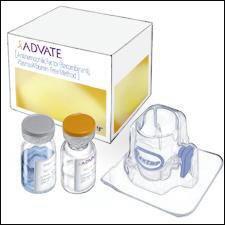
What is the most important information I need to know about ADVATE?
Do not attempt to do an infusion to yourself unless you have been taught how by your doctor or hemophilia center.
You must carefully follow your doctor's or other healthcare provider's instructions regarding the dose and schedule for infusing ADVATE so that your treatment will work best for you.
What is ADVATE?
ADVATE is a medicine used to replace clotting factor (Factor VIII or antihemophilic factor) that is missing in people with hemophilia A (also called "classic" hemophilia). Hemophilia A is an inherited bleeding disorder that prevents blood from clotting normally.
ADVATE is used to prevent and control bleeding in people with hemophilia A.
ADVATE is not used to treat von Willebrand's Disease.
Who should not use ADVATE?
You should not use ADVATE if you
- are allergic to mouse or hamster proteins.
- are allergic to any ingredients in ADVATE.
Tell your healthcare provider if you are pregnant or breast-feeding because ADVATE many not be right for you.
How should I use ADVATE?
ADVATE is given directly into the blood stream.
You may infuse ADVATE at a hemophilia treatment center, at your healthcare provider's office or in your home. You should be trained on how to do infusions by your hemophilia treatment center or healthcare provider. Many people with hemophilia A learn to infuse their ADVATE by themselves or with the help of a family member.
Your healthcare provider will tell you how much ADVATE to use based on your weight, the severity of your hemophilia A, and where you are bleeding.
You may have to have blood tests done after getting ADVATE to be sure that your blood level of Factor VIII is high enough to clot your blood.
Call your healthcare provider right away if your bleeding does not stop after taking ADVATE.
What should I tell my healthcare provider before I use ADVATE?
You should tell your healthcare provider if you
- have or have had any medical problems.
- take any medicines, including non-prescription medicines and dietary supplements.
- have any allergies, including allergies to mouse or hamster proteins.
- are nursing.
- are pregnant.
- have been told that you have inhibitors to Factor VIII (because Factor VIII may not work for you).
What are the possible side effects of ADVATE?
You could have an allergic reaction to ADVATE.
Call your healthcare provider right away and stop treatment with ADVATE if you get a rash or hives, itching, tightness of the throat, chest pain or tightness, difficulty breathing, light-headed, dizziness, nausea or fainting.
Side effects that have been reported with ADVATE include:
| cough | headache | joint swelling |
| sore throat | fever | itching |
| unusual taste | dizziness | hematoma |
| abdominal pain | hot flashes | swelling of legs |
| diarrhea | chills | |
| nausea | sweating |
These are not all the possible side effects with ADVATE.
What are the ADVATE dosage strengths?
ADVATE comes in six different dosage strengths. The actual strength will be imprinted on the label and on the box. The six different strengths are coded, as follows:
 | Nominal dosage strength of approximately 250 IU per vial (200 – 400 IU/vial). |
 | Nominal dosage strength of approximately 500 IU per vial (401 – 800 IU/vial). |
 | Nominal dosage strength of approximately 1000 IU per vial (801 – 1200 IU/vial). |
 | Nominal dosage strength of approximately 1500 IU per vial (1201 – 1800 IU/vial). |
 | Nominal dosage strength of approximately 2000 IU per vial (1801 – 2400 IU/vial). |
 | Nominal dosage strength of approximately 3000 IU per vial (2401 – 3600 IU/vial |
Always check the potency printed on the label to make sure you are using the strength prescribed by your doctor. Always check the expiration date printed on the box. You should not use the product after the expiration date printed on the box.
How do I store ADVATE?
Do not freeze ADVATE.
ADVATE vials containing powdered product (without sterile diluent added) should be stored in a refrigerator (2° to 8°C [36° to 46°F]) or at room temperature (up to 30°C [86°F]) for up to 6 months.
If you choose to store ADVATE at room temperature:
- note the date that the product is removed from refrigeration on the box.
- do not use after six months from this date or the expiration date listed on the vial, whichever is earlier.
Store vials in their original box and protect them from extreme exposure to light.
Reconstituted product (after mixing dry product with wet diluent) must be used within 3 hours and cannot be stored or refrigerated. Any ADVATE left in the vial at the end of your infusion should be discarded.
What else should I know about ADVATE and hemophilia A?
Your body may form inhibitors to Factor VIII. An inhibitor is part of the body's normal defense system. If you form inhibitors, it may stop ADVATE from working properly. Consult with your healthcare provider to make sure you are carefully monitored with blood tests for the development of inhibitors to Factor VIII.
Medicines are sometimes prescribed for purposes other than those listed here. Do not use ADVATE for a condition for which it is not prescribed. Do not share ADVATE with other people, even if they have the same symptoms that you have.
Resources at Baxter available to the patients:
For more product information on ADVATE, please visit www.advate.com or call 1-888-4ADVATE (1-888-423-8283).
For information on patient assistance programs that are available to you, including the Baxter CARE Program, please contact the Baxter Insurance Assistance Helpline at 1-888-BAXTER9 (1-888-229-8379).
For information on additional Baxter patient resources, please visit www.advate.com.
INSTRUCTIONS FOR USE
ADVATE
[Antihemophilic Factor (Recombinant), Plasma/Albumin Free Method]
(For intravenous use only)
Do not attempt to do an infusion to yourself unless you have been taught how by your doctor or hemophilia center.
See the step-by-step instructions for reconstituting ADVATE at the end of this leaflet.
You should always follow the specific instructions given by your healthcare provider. The steps listed below are general guidelines for using ADVATE. If you are unsure of the procedures, please call your healthcare provider before using.
Call your healthcare provider right away if bleeding is not controlled after using ADVATE.
Your healthcare provider will prescribe the dose that you should take.
Your healthcare provider may need to take blood tests from time to time.
Talk to your healthcare provider before traveling. You should plan to bring enough ADVATE for your treatment during this time.
Dispose of all materials, including any leftover reconstituted ADVATE product, in an appropriate container.
- In a quiet place, prepare a clean flat surface and gather all the materials you will need for the infusion. Check the expiration date, and let the vial with the ADVATE concentrate and the Sterile Water for Injection, USP (diluent) warm up to room temperature. Wash your hands and put on clean exam gloves. If infusing yourself at home, the use of gloves is optional.
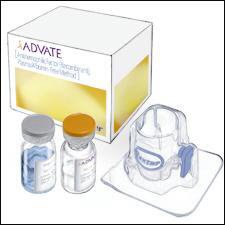
- Remove caps from the ADVATE concentrate and diluent vials to expose the centers of the rubber stoppers.
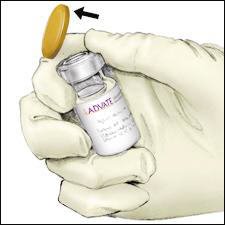
- Disinfect the stoppers with an alcohol swab (or other suitable solution suggested by your doctor or hemophilia center) by rubbing the stoppers firmly for several seconds, and allow them to dry prior to use. Place the vials on a flat surface.
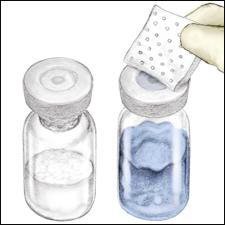
- Open the BAXJECT II device package by peeling away the lid, without touching the inside of the package. Do not remove the BAXJECT II device from the package.
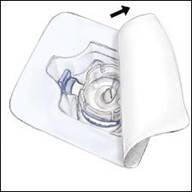
- Turn the package with the BAXJECT II device upside down, and place it over the top of the diluent vial. Fully insert the clear plastic spike of the device into the center of the diluent vial's stopper by pushing straight down. Grip the package at its edge and lift it off the device. Be careful not to touch the white plastic spike. Do not remove the blue cap from the BAXJECT II device.
The diluent vial now has the BAXJECT II device connected to it and is ready to be connected to the ADVATE vial.
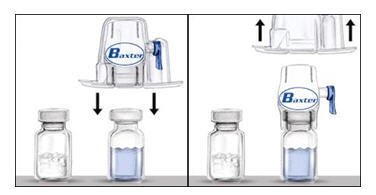
- To connect the diluent vial to the ADVATE vial, turn the diluent vial over and place it on top of the vial containing ADVATE concentrate. Fully insert the white plastic spike into the ADVATE vial's stopper by pushing straight down. Diluent will flow into the ADVATE vial. This should be done right away to keep the liquid free of germs.
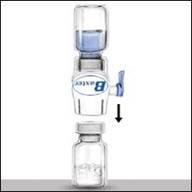
- Swirl the connected vials gently and continuously until the ADVATE is completely dissolved. Do not shake. The ADVATE solution should look clear and colorless. If not, do not use it and notify Baxter immediately.
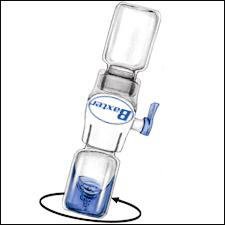
- Take off the blue cap from the BAXJECT II device and connect the syringe. BE CAREFUL TO NOT INJECT AIR.
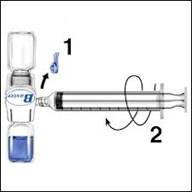
- Turn over the connected vials so that the ADVATE vial is on top. Draw the ADVATE solution into the syringe by pulling back the plunger slowly. Disconnect the syringe from the vials. Attach the infusion needle to the syringe using a winged (butterfly) infusion set, if available. Point the needle up and remove any air bubbles by gently tapping the syringe with your finger and slowly and carefully pushing air out of the syringe and needle.
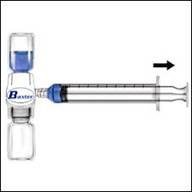
- If you are using more than one vial of ADVATE, the contents of more than one vial may be drawn into the same syringe. However, you will need a separate diluent and BAXJECT II device to mix each additional vial of ADVATE.
Apply a tourniquet, and get the injection site ready by wiping the skin well with an alcohol swab (or other suitable solution suggested by your doctor or hemophilia center).
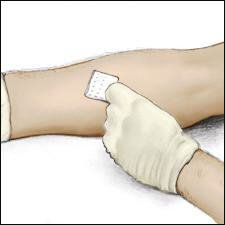
- Insert the needle into the vein, and remove the tourniquet. Slowly infuse the ADVATE. Do not infuse any faster than 10 mL per minute.
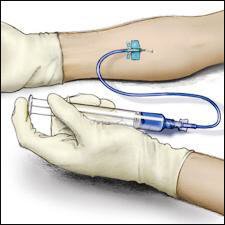
- Take the needle out of the vein and use sterile gauze to put pressure on the infusion site for several minutes.
Do not recap the needle. Place it with the used syringe in a hard-walled Sharps container for proper disposal.
Remove the peel-off label from the ADVATE vial and place it in your logbook. Clean any spilled blood with a freshly prepared mixture of 1 part bleach and 9 parts water, soap and water, or any household disinfecting solution.
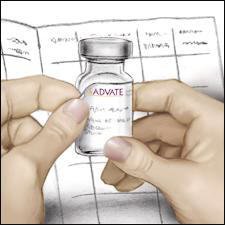
- Dispose of the used vials and BAXJECT II system in your hard-walled Sharps container, without taking them apart. Do not dispose of these supplies in ordinary household trash.
Important: Contact your doctor or local Hemophilia Treatment Center if you experience any problems.
BAXTER, ADVATE, BAXJECT, and CARE are trademarks of Baxter International Inc. registered in the U.S. Patent and Trademark Office.
U.S. Patent Numbers:
4,757,006; 5,198,349; 5,250,421; 5,733,873; 5,919,766; 4,891,319; 5,955,448; 6,313,102; 5,891,873; 6,034,080; 6,649,386; 5,854,021; 5,470,954; 6,555,391; 6,936,441; 7,094,574; 6,100,061; 6,475,725; 6,586,573; 7,087,7236,475,725; 6,100,061; 6,586,573; 6,555,391; 5,198,349; 4,757,006; 5,470,954
Baxter Healthcare Corporation
Westlake Village, CA 91362 USA
U.S. License No. 140
Printed in USA
Issued Oct, 2009
PRINICIPAL DISPLAY PANEL
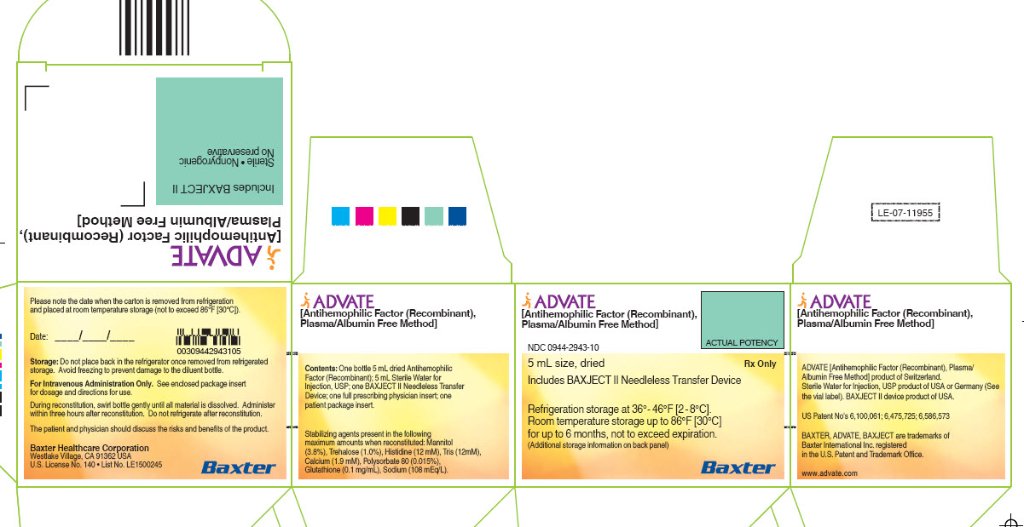
ADVATE 1000 IU unit carton
ADVATE
[Antihemophilic Factor (Recombinant)Plasma/Albumin-Free Method]
NDC 0944-2943-10
5 mL size, dried
ACTUAL POTENCY
Rx Only
Includes BAXJECT II Needleless Transfer Device
Refrigeration storage at 36º - 46ºF [2-8ºC].
Room temperature storage up to 86ºF [30ºC].
(Additional storage information on back panel)

ADVATE 1000 IU vial label
ADVATE
[Antihemophilic Factor (Recombinant) Plasma/Albumin-Free Method]
NDC 0944-2943-01
For intravenous administration only.
Rx Only
See accompanying package insert for full prescribing information.
Baxter Healthcare Corporation
Westlake Village, CA 91362 USA
US License #140
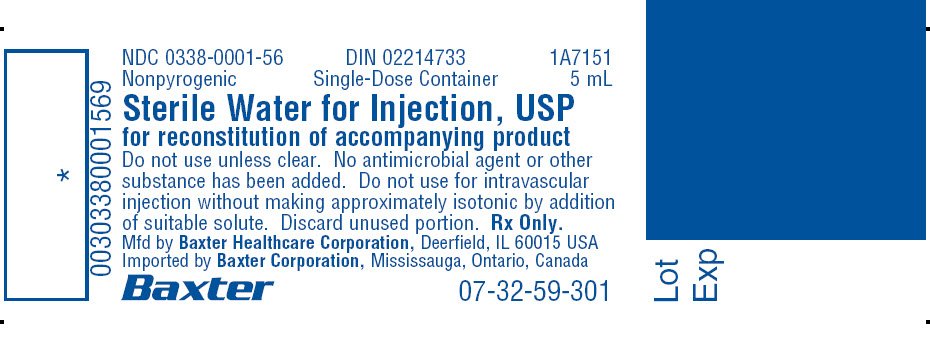
Sterile Water for Injection 5 mL vial label
NDC 0338-0001-56
DIN 02214733
Nonpyrogenic
Single-Dose Container
5 mL
Sterile Water for Injection, USP
for reconstitution of accompanying product
Do not use unless clear. No antimicrobial agent or other substance has been added. Do not use for intravascular injection without making approximately isotonic by addition of suitable solute. Discard unused portion. Rx Only.
Mfd by Baxter Healthcare Corporation, Deerfield, IL 60015 USA
Imported by Baxter Corporation, Mississauga, Ontario, Canada
| ADVATE
antihemophilic factor, human recombinant kit |
||||||||||||||||||
|
||||||||||||||||||
|
||||||||||||||||||
|
||||||||||||||||||
|
||||||||||||||||||
|
||||||||||||||||||
|
||||||||||||||||||
|
||||||||||||||||||
|
||||||||||||||||||
|
||||||||||||||||||
|
||||||||||||||||||
|
||||||||||||||||||
|
||||||||||||||||||
|
||||||||||||||||||
|
||||||||||||||||||
|
||||||||||||||||||
|
||||||||||||||||||
|
||||||||||||||||||
| Marketing Information | |||
| Marketing Category | Application Number or Monograph Citation | Marketing Start Date | Marketing End Date |
| BLA | BLA125063 | 08/19/2010 | |
| ADVATE
antihemophilic factor, human recombinant kit |
||||||||||||||||||
|
||||||||||||||||||
|
||||||||||||||||||
|
||||||||||||||||||
|
||||||||||||||||||
|
||||||||||||||||||
|
||||||||||||||||||
|
||||||||||||||||||
|
||||||||||||||||||
|
||||||||||||||||||
|
||||||||||||||||||
|
||||||||||||||||||
|
||||||||||||||||||
|
||||||||||||||||||
|
||||||||||||||||||
|
||||||||||||||||||
|
||||||||||||||||||
|
||||||||||||||||||
| Marketing Information | |||
| Marketing Category | Application Number or Monograph Citation | Marketing Start Date | Marketing End Date |
| BLA | BLA125063 | 08/19/2010 | |
| ADVATE
antihemophilic factor, human recombinant kit |
||||||||||||||||||
|
||||||||||||||||||
|
||||||||||||||||||
|
||||||||||||||||||
|
||||||||||||||||||
|
||||||||||||||||||
|
||||||||||||||||||
|
||||||||||||||||||
|
||||||||||||||||||
|
||||||||||||||||||
|
||||||||||||||||||
|
||||||||||||||||||
|
||||||||||||||||||
|
||||||||||||||||||
|
||||||||||||||||||
|
||||||||||||||||||
|
||||||||||||||||||
|
||||||||||||||||||
| Marketing Information | |||
| Marketing Category | Application Number or Monograph Citation | Marketing Start Date | Marketing End Date |
| BLA | BLA125063 | 08/19/2010 | |
| ADVATE
antihemophilic factor, human recombinant kit |
||||||||||||||||||
|
||||||||||||||||||
|
||||||||||||||||||
|
||||||||||||||||||
|
||||||||||||||||||
|
||||||||||||||||||
|
||||||||||||||||||
|
||||||||||||||||||
|
||||||||||||||||||
|
||||||||||||||||||
|
||||||||||||||||||
|
||||||||||||||||||
|
||||||||||||||||||
|
||||||||||||||||||
|
||||||||||||||||||
|
||||||||||||||||||
|
||||||||||||||||||
|
||||||||||||||||||
| Marketing Information | |||
| Marketing Category | Application Number or Monograph Citation | Marketing Start Date | Marketing End Date |
| BLA | BLA125063 | 08/19/2010 | |
| ADVATE
antihemophilic factor, human recombinant kit |
||||||||||||||||||
|
||||||||||||||||||
|
||||||||||||||||||
|
||||||||||||||||||
|
||||||||||||||||||
|
||||||||||||||||||
|
||||||||||||||||||
|
||||||||||||||||||
|
||||||||||||||||||
|
||||||||||||||||||
|
||||||||||||||||||
|
||||||||||||||||||
|
||||||||||||||||||
|
||||||||||||||||||
|
||||||||||||||||||
|
||||||||||||||||||
|
||||||||||||||||||
|
||||||||||||||||||
| Marketing Information | |||
| Marketing Category | Application Number or Monograph Citation | Marketing Start Date | Marketing End Date |
| BLA | BLA125063 | 08/19/2010 | |
| ADVATE
antihemophilic factor, human recombinant kit |
||||||||||||||||||
|
||||||||||||||||||
|
||||||||||||||||||
|
||||||||||||||||||
|
||||||||||||||||||
|
||||||||||||||||||
|
||||||||||||||||||
|
||||||||||||||||||
|
||||||||||||||||||
|
||||||||||||||||||
|
||||||||||||||||||
|
||||||||||||||||||
|
||||||||||||||||||
|
||||||||||||||||||
|
||||||||||||||||||
|
||||||||||||||||||
|
||||||||||||||||||
|
||||||||||||||||||
| Marketing Information | |||
| Marketing Category | Application Number or Monograph Citation | Marketing Start Date | Marketing End Date |
| BLA | BLA125063 | 08/19/2010 | |
| Labeler - Baxter Healthcare Corporation (039121363) |
| Establishment | |||
| Name | Address | ID/FEI | Operations |
| Baxter SA | 370191025 | MANUFACTURE | |
| Establishment | |||
| Name | Address | ID/FEI | Operations |
| Baxter Healthcare Corporation | 001728059 | MANUFACTURE | |
